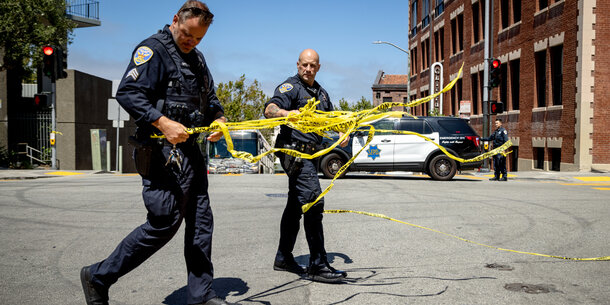You’re reading The Briefing, Michael Waldman’s weekly newsletter. Click here to receive it in your inbox.
Donald Trump stoked fears of a migrant-fueled crime wave at the Conservative Political Action Conference on Saturday, describing the United States under President Biden as awash in “bloodshed, chaos, and violent crime.” It was a near cut-and-paste from his CPAC speech last year, when he warned that the country was becoming a “lawless, open borders, crime-ridden, filthy, communist nightmare.”
This is nothing new — presidential candidates have been telling Americans scary stories about dark-skinned criminals for their own political gain for a very long time. Trump’s stories, however, don’t line up with reality, as my colleagues Lauren-Brooke Eisen and Ames Grawert explain in a recent article on our website.
The first problem with Trump’s narrative is the timeline. The spike in violent crime happened on Trump’s watch, not Biden’s. In 2020, the final year of the Trump presidency, murder rose by nearly 30 percent and assault by more than 10 percent. Crime surges are almost always multifactorial, and the Covid-19 pandemic and associated economic upheaval played a major role in the historic 2020 crime surge. One cause, though, most certainly was not the Biden presidency, which had not yet begun.
Since Biden took office, violent crime appears to be on a downward trend. As of 2022, violent crime rates had fallen by 4 percent and murder rates by roughly 7 percent since 2020, according to the FBI. Those numbers haven’t returned us to pre-Covid levels, unfortunately, but the trend lines certainly don’t suggest that Biden’s policies — or anyone’s policies since 2020 — caused a crime surge. The more likely explanation is that, following a decades-long decline in violent crime, the pandemic initiated a spike that is in the process of receding.
Trump’s other baseless crime-related claim at CPAC was that newly arrived migrants are responsible for violent crime. He predicted that the current wave of migration will be “far more deadly than anyone thought.” There is no evidence to support this narrative. New York City, for example, has absorbed more than 150,000 migrants since the spring of 2022. Violent crime did not increase during that time. Moreover, research conducted before the pandemic suggests that undocumented immigrants are not a major source of crime, contrary to Trump’s claim.
For decades, crime was the most potent wedge issue. Such inflammatory topics aimed to cause disagreement between white voters and voters of color. That was easier in years when violence soared and cities spiraled as a result. Gentlemanly George H.W. Bush won the presidency using scary advertisements about Willie Horton, a Black man who had raped a white woman while out on a weekend furlough from prison. Lee Atwater, Bush’s strategist, vowed to make Horton “Michael Dukakis’s running mate.” It helped propel Bush to the White House.
But over the past decade, there has been a heartening bipartisan movement to reform criminal justice laws. In 2016, candidates jostled to denounce “mass incarceration.” Trump signed the First Step Act — a sentencing and prison reform bill — and featured formerly incarcerated people sitting in the gallery during the State of the Union.
So Trump’s turn to xenophobic bombast, while not a surprise, is unsettling. With the economy strengthening, immigration will be a dominant issue. Here as in other countries, for reasons good and bad, millions of people are crossing borders. If some commit crimes, it will become fodder for campaign attacks. Social media and right-wing broadcasters will amplify each attack. The next Willie Horton will debut in the Daily Mail online.
Over the course of this year, the Brennan Center will fight fear with facts. Panic leads to bad policy. It risks upending the long-standing bipartisan coalition that supports meaningful criminal justice reform. We’ll be keeping close track of the false claims of politicians of both parties throughout this election season, and we’ll be a reliable source for sober, clear, and honest analysis of crime trends. Keep watching this space.



